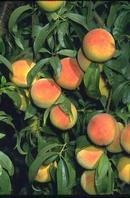Gardening Questions Answered
Deep Watering Schedule for Fruit and Nut Trees
How do I make sure that my fruit and nut trees are getting enough water in this summer heat?
To produce good yields, deciduous fruit and nut trees need some available soil moisture continuously from bloom to harvest. Evergreen trees such as citrus need soil moisture during both summer and fall to maintain leaves and fruit size.
Water use by fruit trees is very similar between species. The greatest difference in water use is due to tree size. For example, a tree that occupies 36 sq. feet (6 x 6) uses 5.6 gallons of water per day; a tree that is about three times as large, 100 sq. feet (10 x 10) uses almost 3x as much water (15.6 gallons per day). This is based on a typical hot midsummer day using 0.25 inches of water a day. Water use for a medium-sized semidwarf fruit tree is about 19 gallons of water per day (0.3in/day) throughout the hottest days during our Central Valley summer.
The roots of most fruit and nut trees extend out well past the drip line or canopy edge and well down into the soil to about 6-7 feet. To get water down to that level, create a berm or basin around the trees at the drip line and slowly fill with water, letting the water run for several hours. Water more frequently when temperatures are high, especially when above 100 degrees F. Let the top 8-10 inches of soil dry out between waterings. Citrus should have consistent moisture in the soil and will need more frequent watering-when the top 3-4 inches of soil have dried out.
Bubblers work well, slowly soaking the soil. A 3-4 foot length of PVC pipe with holes drilled into the pipe can be inserted into the soil at the drip line and a hose slowly trickling water can be stuck into the pipe. Drip emitters are extremely efficient, keep weeds down and make it easy to gauge the amount of water given when using 1-gallon-per-hour-emmiters. A tree in the Central Valley requiring 19 gallons of water per day would need 9-10 hours of daily watering with two 1-gallon-per-hour drip emitters. The use of drip emitters increases root density at the watering site and ensures adequate water uptake.
